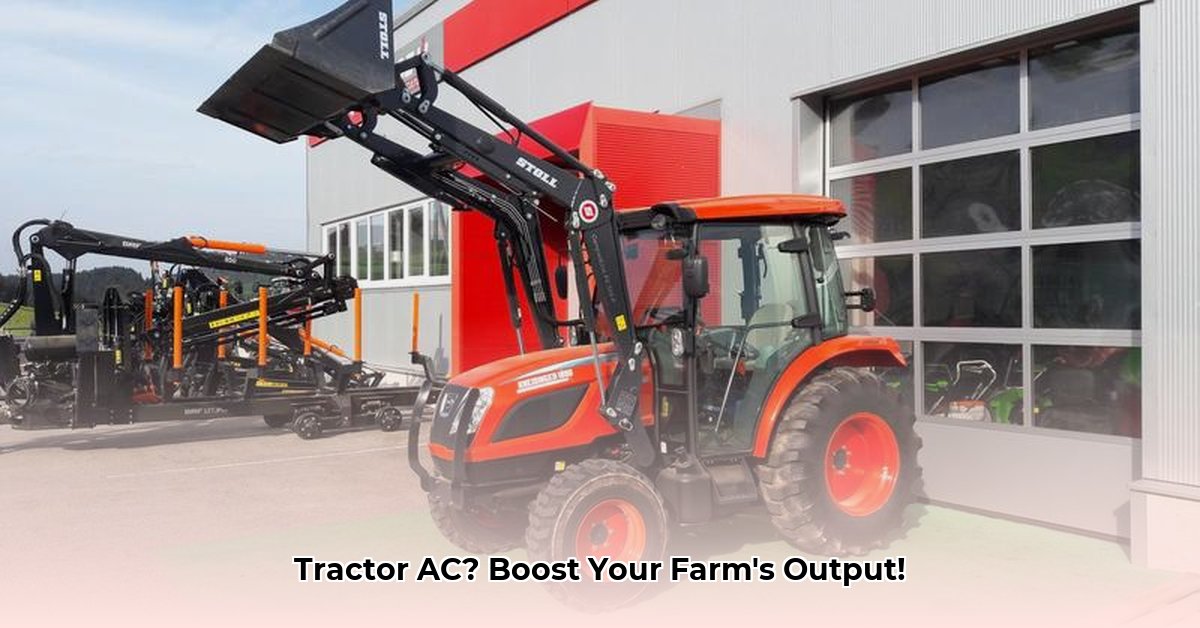
Do Tractors Have Air Conditioning?
The question of whether tractors have air conditioning isn't a simple yes or no. The availability of air conditioning (AC) in tractors depends on several factors, including the brand, model, year of manufacture, and whether it was selected as an optional extra. Some modern tractors offer AC as a standard feature, while others do not. This variability underscores the importance of checking specifications before purchasing or leasing a tractor. Understanding these nuances is vital for maximizing productivity and operator well-being. For more detailed information, check out this helpful resource: Tractor AC guide.
Comfort in the Cab: Beyond a Mere Convenience
Tractor air conditioning is more than a comfort feature; it's a significant productivity enhancer. Working long hours in extreme heat leads to fatigue, reduced concentration, and increased risk of heatstroke, impacting both efficiency and safety. A well-maintained AC system directly translates to a more productive and healthier work environment for farmers. This translates to improved yield and a stronger bottom line. A comfortable operator equates to higher precision and fewer errors.
Stakeholder Benefits of Tractor Air Conditioning
The benefits of tractor AC extend beyond the farmer. Consider the impact on various stakeholders:
Farmers: Experience reduced fatigue, improved focus, and a lower risk of heat-related illnesses, all contributing to increased efficiency and profitability.
Mechanics: While routine maintenance is straightforward (checking refrigerant levels, belt tension, condenser cleanliness), more serious AC repairs require specialized expertise leading to increased operational costs. Proactive maintenance greatly minimizes such expensive interventions.
Tractor Manufacturers: Offering reliable AC systems enhances brand reputation and customer satisfaction, becoming a key selling point in a competitive market. Innovation in sustainable and energy-efficient AC technology is paramount.
Policymakers and Researchers: Advances in tractor AC contribute to sustainable agriculture, driving research into eco-friendly refrigerants and improved energy efficiency. Government policies can incentivize the adoption of sustainable technologies.
Maintaining Your Tractor's Cooling System: A Practical Guide
Maintaining your tractor's AC system requires regular attention. Follow this actionable guide:
Regular Inspections: Incorporate routine AC checks into your regular maintenance schedule. This includes verifying refrigerant levels, inspecting belt tension, and ensuring the condenser is clean and free from obstructions.
Professional Intervention: For significant issues like leaks or compressor malfunctions, consult a qualified mechanic. Improper repairs can lead to more severe and costly problems.
Sustainable Refrigerants: Prioritize environmentally friendly refrigerants during recharge. Consult your manual or a qualified technician for proper refrigerant handling and selection.
Preventative Measures: Regular condenser cleaning is essential to maintain optimal airflow and prevent degradation of components. Address refrigerant leaks promptly.
Retrofitting Older Tractors: A Cost-Effective Investment?
Retrofitting older tractors with AC can significantly enhance operator comfort and productivity. While initially costly, the improved worker well-being and efficiency often justify the upgrade. This is especially relevant for sustainable farming practices, as worker health is a priority.
The Future of Tractor AC: Sustainability at the Forefront
The agricultural industry is moving towards sustainable practices. This includes the adoption of eco-friendly refrigerants and the design of energy-efficient AC systems. Ongoing research is focused on minimizing the environmental impact of tractor AC. Future regulations may mandate the use of specific refrigerants, further driving innovation.
Environmental Impact: Balancing Comfort and Responsibility
While AC is crucial for productivity, its impact on climate change via refrigerants must be considered. The industry is transitioning towards low-global-warming-potential (GWP) refrigerants, but continuous improvement is needed.
Choosing Sustainable Refrigerants for Tractor Air Conditioning: A Detailed Guide
Key Takeaways:
- Air conditioning is increasingly essential in modern tractors for productivity and operator well-being.
- Environmental regulations are driving the transition to sustainable refrigerants.
- The choice of refrigerant involves assessing environmental impact, cost, safety, and availability.
- Several low-GWP options exist, each with its advantages and disadvantages.
Selecting the right refrigerant requires careful consideration:
- Assess Your Needs: Consider tractor size and type to determine compatibility with different refrigerants.
- Environmental Impact: Prioritize refrigerants with the lowest GWP. Explore options such as HFOs, CO2, or ammonia.
- Cost Analysis: Account for initial investment costs, maintenance requirements, and refrigerant life-cycle.
- Safety Measures: Assess the safety implications of each refrigerant, including flammability and toxicity.
- Availability and Support: Ensure refrigerant availability and accessible technical support in your region.
This informed approach ensures both the productivity gains of tractor AC and adherence to environmental sustainability goals.